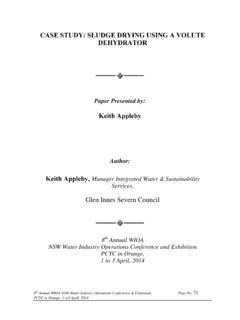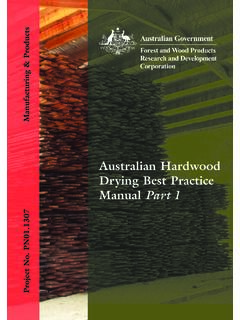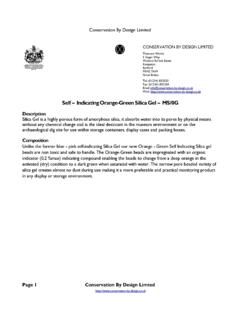Transcription of Fire & Explosion Investigation Essay Assignment ...
1 Fire & Explosion InvestigationEssay AssignmentSpontaneous combustion of drying Oils as a Fire CauseDue Date:- l/5/00 Kelly Rampling RamplingKelly Rampling; 1 /5/OOSpontaneous combustion of drying Oils as a Fire CauseAbstract:- spontaneous combustion occurs when the temperature of a material increases, without drawing heat from thesurroundings, until the ignition temperature of that material is which are susceptible to thisprocess, under the right conditions include sawdust, oily materials (including drying oils), hay, waste paper,coal and charcoal, pyrophoric metals and incompatible chemicals,Due to the nature of the drying oilsemployed in paint manufacture all paints and oil varnishes, which contain drying oils, are capable of self-heating to the point of ignition when they are in contact with cellulosic materials and majority ofspontaneous combustion is due to an oxidation materials can undergo an oxidation processwhich results in the generation of heat.
2 However, most substances which are susceptible to oxidation will notspontaneously combust if this process is slow and any heat generated is so small that an increase intemperature of that material is example of this is the rusting of normaltemperatures, this oxidation process will not result in spontaneous are three conditionswhich are important in the spontaneous ignition are: (i.) rate of heat generation, (ii.) air supplyand (iii.) insulation properties of the immediate loosely packed pile of drying oil soakedcloths may spontaneously combust whereas a tightly packed pile or a single cloth on a clothes line will case of a single cloth on a clothes line, although there is sufficient air supply to accommodate oxidation,any heat generated will be carried off quicker than it is oils are commonly found in paints andvarnishes due to their drying effects and they are the non-saturated oils found in vegetable and examples include linseed oil.
3 Soya bean oil and tung hydrocarbon oils such asthose found in petroleum products are not susceptible to spontaneous heating at normal temperatures. Fatsand oils are not likely to oxidise sufficiently fast in bulk liquid most commonly occurs whenthese oils are spread out in the form of a thin layer, such as on a rag or is because the surface areaof the oil is maximised and thus exposure to oxygen is also maximised and the reaction occurs of a spontaneous combustion fire is very difficult due to the fact that there are no significant fireresidues left by this.
4 When flaming ignition occurs the chemical detection of residues of thepreliminary material may be the Investigation of a suspected spontaneous combustion fire thereare a number of diagnostic signs to look for. The major one being the presence of more fire damage to themiddle of a material mass than around the edges. In spontaneous ignition the most severe fire damage willmost often be in the centre of the fuel mass and in very large masses there may also be several separatepockets of smouldering which may lead to several points of origin, Other signs of spontaneous ignition includea brown discolouration of the fuel mass and an acrid brown discolouration, it has been suggested.
5 Is not just a result of charring but may be the product of reactions between amino acids and reducing acrid odours are a result of aldehydes being present in the smoke later in the ignition smokeis produced when the heat resulting from the oxidation process evaporates any moisture present from thesurrounding indicator of whether or not a fire was caused by spontaneous combustion may beits behaviour when suppression of the fire is attempts may only result in momentarysuppression of the flames followed by prevention of spontaneous combustion in drying oils has until recently been a difficult flame retardants to drying oils may lead to changes in oil s physical retardants may makethe oil brittle, tacky or stiff, whilst others may have effects on the colouration, transparency, appearance.
6 Resistance to light or heat and its these properties are very important in the use of drying oils itis essential that flame retardants are selected in such a way as not to affect the materials to the extent that theyare then unsuitable for problems can be overcome by the addition of flame retardant halogenatedcompounds, followed by further addition of phosphorous compounds, to the drying oil formulation. Hence,the added compounds create a combustion resistant formulation which function is not adversely :- spontaneous combustion is defined as occurring when the temperature of certain materials increases, withoutdrawing heat from the surroundings, until the ignition temperature of the material is reached and henceignition occurs,The majority of spontaneous combustion occurs when the material undergoes oxidation withthe air resulting in the evolution of , most substances which are susceptible to oxidation willnot spontaneously combust if this process is slow and any heat generated is so small that an increase intemperature of that material is unmeasurable.
7 An example of this is the rusting of normaltemperatures, this oxidation process will not result in spontaneous combustion is commonly associated with accidental fires but it does not rule out conditions for spontaneous combustion to occur may be set up by an are three conditions which are important in the determination of whether an oxidation reaction willresult in the dangerous heating of a material and subsequent spontaneous conditions are:-l Rate of heat generationl Air supplyl Insulation properties of the immediate surroundingsThe air supply is important in that there must be enough oxygen present to permit the oxidation process butnot so much that any heat produced by the reaction is carried away by convection as rapidly as it is.
8 A loosely packed pile of oily rags may undergo spontaneous combustion whereas a tightly packed pileor a single oily rag hung on a clothes line will the oxidation process materials subject to thereaction will first form products of partial oxidation which may then act as catalysts for further of this is that olive oil which has been exposed to air, and become rancid, will have a higher rate ofoxidation than that of pure, fresh and previously unexposed olive heat may also initiate spontaneous ignition of some combustible materials which would not besubject to this process at normal temperatures,In these cases, the increase in the temperature of thesurroundings leads to an increase in the rate of oxidation so much so that the heat is being produced morerapidly than it can be of this are foam rubber and cotton cloths which have been heated in which may be subject to spontaneous combustion , under the right conditions, include.
9 -l Sawdustl Oily materials (including drying oils)l Hayl Waste paperl Coal and charcoall Pyrophoric metalsl Incompatible chemicalsl Oxidising agents etcFatty oils are a more common cause of fires caused by spontaneous combustion and can be categorised asbeing either drying , semi- drying or non- drying oils. drying oils are commonly found in paints and varnishesdue to their drying effects and they are the non-saturated oils found in vegetable and animal include linseed oil, soya bean oil and tung hydrocarbon oils such as those found inpetroleum products are not susceptible to spontaneous heating at normal and oils are not likely to oxidise sufficiently fast in bulk liquid most commonly occurswhen these oils are spread out in the form of a thin layer.
10 Such as on a rag or is because the surfacearea of the oil is maximised and thus exposure to oxygen is also maximised and the reaction occurs in very small amounts, such as grams or ounces, these oils have been documented in laboratoryexperiments to result in the spontaneous ignition of their support these tests the supportmaterials had a large surface area and were reduced to small volumes by being placed in a pile rather thanbeing spread oil is prepared by crushing the seeds of the flax plant and is primarily a mixture of the three fatty acidsoleic, linoleic and linolenic acids, The linoleic and linolenic acids will rapidly auto-oxidise in air.










